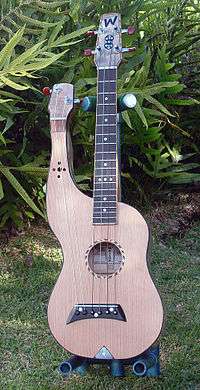Harp ukulele
The term harp ukulele is used to describe two different variants of the ukulele:
- an ukulele with unfretted strings extending from the body, essentially forming a miniature harp guitar
- an ukulele with an "arm" extending from the upper bout, often hollow to increase the volume of the sound chamber, which visually resembles a harp guitar but does not support added strings.

Modern harp ukulele with two harp strings coming from the arm.
History
The harp ukulele appeared in the 1910s, when the harp guitar was experiencing some popularity, and the ukulele had just begun to experience nationwide popularity in the United States due to its use at the Panama–Pacific International Exposition of 1915.
After the popularity of both the harp guitar and ukulele faded, the harp ukulele lost what little market share it had. However, in the late 20th century various luthiers returned to experimenting with the harp ukulele design, both the string-less extended-bout type, as well as the added-strings true harp type.
Early 20th Century harp ukulele luthiers
- Chris Knutsen (Seattle, USA)[1]
Modern makers
- Anuenue
- DL Noble (USA)
- Emerald Guitars (Ireland)
- GRENOSI (Austria)
- Jay Buckey (Ukraine)
- Makoto Tsuruta (Japan)
- Michael Dunn (Canada)
- Thomas Emmett Owen (Hawaii, USA)
- Ziegenspeck (Wales)
gollark: !pingwhen online <@!258639553357676545> Rust.
gollark: !pingwhen online <@!258639553357676545> Rust.
gollark: !pingwhen online <@!258639553357676545> Rust.
gollark: !pingwhen online <@!258639553357676545> Rust.
gollark: !pingwhen online <@!258639553357676545> Rust.
External links
- Gregg Miner. Harp Ukuleles: What On Earth Were They Thinking? Ukulele Occasional, 2004.
References
- Zachary R. Fjestad, S. P. Fjestad Blue Book of Acoustic Guitars Blue Book Publications, Inc. 2003-2005. ISBN 1-886768-58-7
This article is issued from Wikipedia. The text is licensed under Creative Commons - Attribution - Sharealike. Additional terms may apply for the media files.